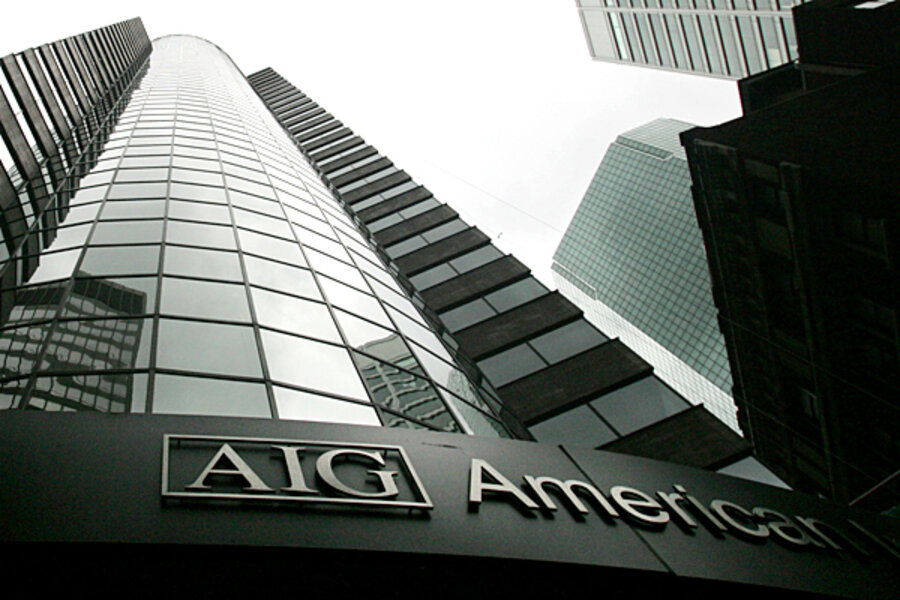Could AIG plan to exit bailout bring taxpayers a profit?
Loading...
A new agreement between insurance company AIG and the US Treasury could pave the way for American taxpayers to get back the rescue money they provided in one of the most controversial actions during the financial crisis.
It's not a sure thing that taxpayers will be reimbursed in full. But the plan at least outlines a path by which the government and American International Group Inc. (AIG) can untie the knot that has bound them together since the fall of 2008.
“The exit strategy announced today dramatically accelerates the timeline for AIG’s repayment and puts taxpayers in a considerably stronger position to recoup our investment in the company,” Treasury Secretary Timothy Geithner said in a statement released Thursday morning. “While there is a lot of work ahead to execute the terms of this agreement, today we are much closer to seeing a clear path out."
The plan involves converting bailout money into a common-stock ownership stake in AIG, which the Treasury would sell over time. If that could be done overnight at today's share price, taxpayers might actually turn a profit.
But the exit plan isn't a quick or simple process. For one thing, AIG also owes billions of dollars in bailout money to the Federal Reserve. The company expects to pay back the Fed and issue common stock to the Treasury by the end of the first quarter of 2011.
Once that's accomplished, AIG's share price could go up or down as the Treasury moves to sell its stake. Turning a taxpayer profit would depend on investors viewing AIG as a strong player in the insurance business.
As explained by AIG, the plan has three parts:
1. The company will repay some $20 billion owed to the Federal Reserve Bank of New York, with funds that come partly from selling subsidiaries such as overseas life-insurance businesses.
2. AIG needs to repay additional rescue funds, worth $26 billion, that were also set up by the Federal Reserve Bank of New York. The firm plans to draw on the Treasury's TARP fund (Troubled Asset Relief Program) for up to $22 billion and pay the additional $4 billion with proceeds from other asset sales. The Treasury, in exchange for its TARP contribution, will end up with a stake (now held at the New York Fed) in AIG's foreign insurance holdings.
3. The TARP's current $49 billion stake in AIG – an investment now held as preferred stock – would be converted to common stock. At that point, the Treasury would own 92 percent of the firm's common stock, and it could begin to sell this stake in the open market.
Sound complicated? Yes, the deal has a lot of moving parts that still need to be finalized. But it holds the possibility that taxpayers will get their money back (along with the Fed) and that AIG will emerge as a firm owned fully by private-sector investors.
The AIG bailout was controversial for its massive size, for the way some of the bailout funds were used, and for the way in which the company got into trouble in the first place. The insurance giant issued lots of credit-default swaps, bets on the likelihood of default by other parties. It didn't set aside enough capital to cover losses on those contracts when the economy soured.
More than $100 billion in public funds was deployed to save the firm from collapse. The bailout involved paying big bonuses to AIG employees and paying those credit-default obligations in full, which effectively sent billions of dollars to AIG counterparties including Goldman Sachs and large banks in Europe.
The new exit plan comes as estimates of the broader cost of the TARP have been coming down.
Although the bailouts were not popular with the general public, many economists credit the support for firms like banks and automakers with helping to halt a financial panic at the end of 2008. Without the TARP and follow-on efforts to support the banking system, the recession could have been even worse, they say.
"The fear was that TARP would cost all $700 billion," Secretary Geithner said last week. "The [Congressional Budget Office] now estimates TARP will end up costing us less than a tenth of that – $66 billion."





